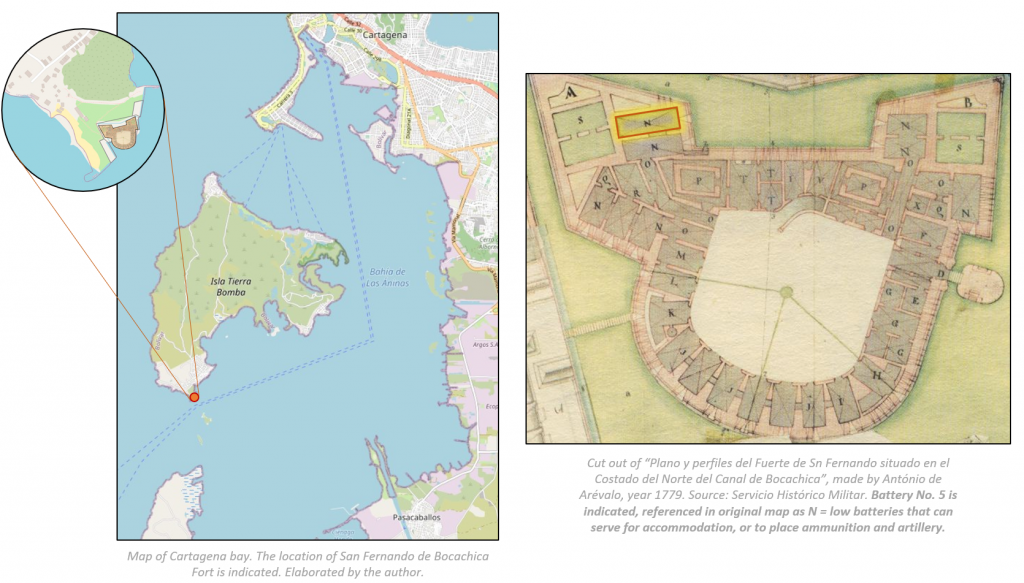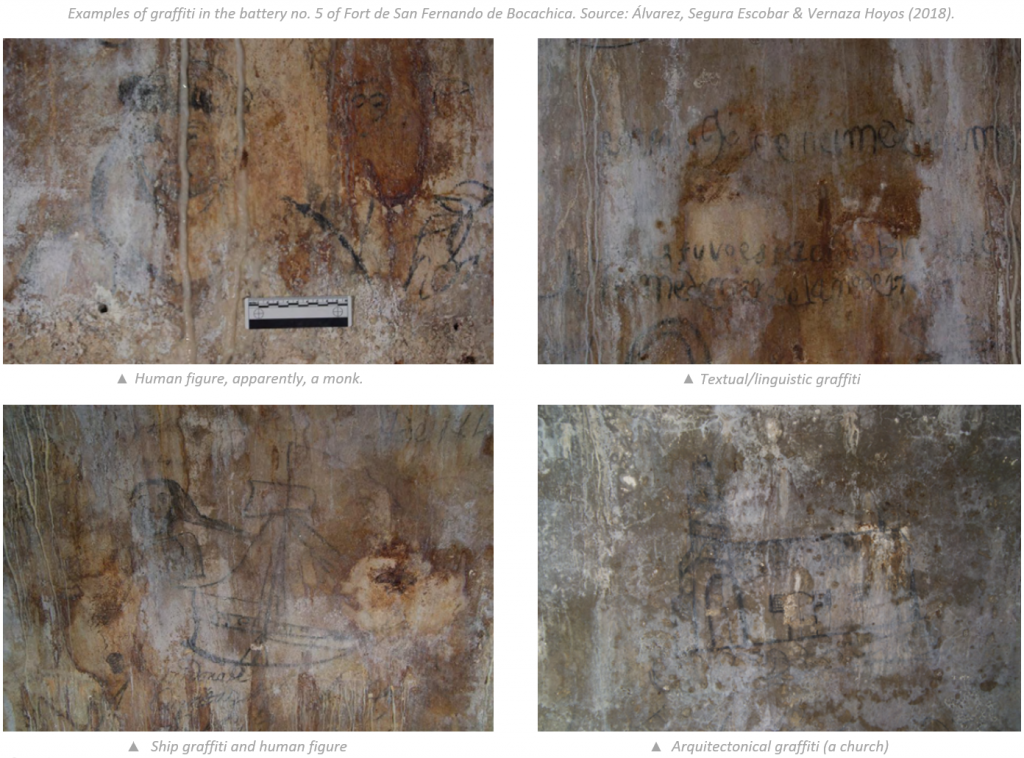MARGINAL VOICES: THE CASE OF HISTORICAL GRAFFITI IN SAN FERNANDO DE BOCACHICA FORT, CARTAGENA DE INDIAS, COLOMBIA
Andrea Amórtegui (andrea.amortegui@est.uexternado.edu.co)
Universidad Externado de Colombia
“As evidence for the material culture of the past, pictorial graffiti’s greatest strength lies in their creators’ potential freedom from the imperatives of organized codes of art, social propriety, and patronage. These images can provide us with a set of unposed snapshots of life in the past, whose richness and vigour may be unmatched in contemporary formal art.” (Le bon, 1997, p. 15)
Introduction
Historical graffiti are characterized by being spontaneous and unofficial manifestations, drawn freehanded on a structural surface, public or private, whose function does not correspond to that of the supports usually used for writing or drawing (Bucherie, 1983, cited in Lorenzo, 2016).
Given its recognizable presence in different times and places all over the world, historical graffiti tell us about the people and their need to communicate, since they represent the voices of those who did not have the power to leave an official record of their lives and had no other means of expression (Rivera-Collazo, 2007).
Ship representations (or nautical graffiti) are a very common type, registered in almost all countries in Europe, as well as in some places of Asia and America. According to the bibliography, it could be said that its highest concentration is in the Mediterranean region, in structures or caves near the coast. Champion (2015) states that the concentration of ship graffiti in coastal sites suggests a strong link between graffiti and communities related to the sea, implying that these had meanings and functions. However, research has focused on their potential as iconographic sources (trying to understand technological details about ships), leaving aside questions about the intention of those who made them.
This thesis project aims to study the historical graffiti located in San Fernando de Bocachica Fort, Cartagena de Indias, Colombia. Based on a previous inventory and conservation work of the graffiti located in battery no. 5, carried out by Álvarez, Segura Escobar and Vernaza Hoyos (2018), this research seeks to advance in the interpretation of the motifs, wondering about their creators’ intentions. Thus, based on the notion of style and the theory of material culture information exchange proposed by Martin Wobst, the objective is to establish the communicative function of the historical graffiti located in battery No. 5 and their relationship with those who made them so that it contributes to the knowledge of military, maritime and prison life during the second half of the eighteenth century and the first half of the nineteenth century in the San Fernando de Bocachica Fort, Cartagena de Indias.
San Fernando de Bocachica Fort
Located at the southern end of Tierrabomba island and built between 1753-1760, San Fernando Fort was strategically planned to defend the Bocachica channel, the only navigable access to the city of Cartagena at that time (Segovia Salas, 1987). Almost from its foundation, Cartagena de Indias was the target of pirates, invasions and wars, reason why its defensive system was of vital importance. However, the effectiveness of the San Fernando Fort had never be tested, since it did not suffer any serious attack (except during the Civil War of 1885) (Paradiso et. al., 2013).

In addition to its use for defense, the San Fernando functioned as a prison. A review of some historical sources has revealed communications about arrests, requests for release, and ill-treatment of prisoners; besides, it has been pointed out that in the early nineteenth century it was the prison of some heroes of the Independence (Antonio Nariño?).

The historical graffiti
Historical graffiti are distributed in different areas of the fort and made with different techniques. Those that were recorded by Álvarez et al. (2018) correspond to the ones located in the low battery no. 5 of the king’s bulwark: a rectangular vaulted space with approximately 85 graffiti randomly distributed on the two longest walls, north wall and south wall. When compared to the presence of graffiti in other parts of the fort, these stand out for their quantity and diversity, because there are drawings of Jesus Christ, the Virgin and some saints, military scenes, numbers, phrases and words, among other human figures in addition to the representations of ships; made at different times and by different hands.

The surviving historical graffiti today in Battery No. 5 are presented to us as sets of unexposed “snapshots” of life in the fort, probably messages from soldiers, prisoners or black slaves (Reyes Suárez, 2019) who found no other means of expression during their stay. In this order of ideas, these graffiti offer us the possibility to listen to a group of unofficial voices, those that, on one hand, left the imperatives and organized art codes of the time through the act of “scratching the walls” , and on the other, voices that have been left out of traditional history.
Understood as popular and informal manifestations, it is proposed that graffiti are acts of communication by their former inhabitants. Following González Gozalo’s ideas (2013), authors of graffiti do not seek aesthethic perfection, but rather expressing a need for dialogue; there is an intention to emit a message and some particular characteristics to achieve it (result of the physical and human environment of its creators). For this reason, the question that will guide this research is: what was the purpose of making graffiti for those who lived in the San Fernando de Bocachica Fort during the second half of the eighteenth century and the first half of the nineteenth century?
References
- Alvarez, M. P., Segura Escobar, J., & Vernaza Hoyos, C. (2018). Registro y estado de conservación preliminar de los dibujos históricos de los fuertes de San Fernando y San José en Bocachica – Cartagena (Unpublished document).
- Champion, M. (2015). Medieval Ship Graffiti in English Churches: Interpretation and function, The Mariner’s Mirror, 101:3, 343-350, DOI: 10.1080/00253359.2015.1054691.
- González Gozalo, E. (2013). Los trazos murales espontáneos, testimonios arqueológicos de nuestra cultura. El caso de Mallorca. Memòries de la Reial Acadèmia Mallorquina d’Estudis Genealògics, Heràldics i Històrics, 5(23), 7-21.
- Le Bon, E. (1997). Images out of water: Aspects of the interpretation of ancient maritime graffiti (Doctoral thesis). University of St. Andrews
- Lorenzo, J. (2016). Grafitos medievales. Un intento de sistematización. En Reyes, F. & Viñuales, G. (Coords.), Grafitos Históricos Hispánicos I. Homenaje a Félix Palomero (pp. 43-58). Madrid, España: José Ignacio Gil Editor. ISBN: 978-84-945761-0-2.
- Paradiso, M., Galassi, S., & Benedetti, S. (2013). Una contribución para conocer el fuerte San Fernando de Bocachica, Cartagena de Indias, Colombia. Revista M, 10 (2) , 136-158.
- Reyes Suárez, M. (2019). Un museo de oficios en el fuerte de San Fernando. Instituto Colombiano de Antropología e Historia.
- Rivera Collazo, I. C. (2007). Graffiti as resource for historical and archaeological research: the figurative graffiti on the walls of San Juan’s spanish defense system, Puerto Rico. Proceedings of the twenty-first congress of the International Association for Caribbean Archaeology.
- Segovia Salas, R. (1987). Las fortificaciones de Cartagena de Indias. Estrategia e Historia. Bogotá: Carlos Valencia Editores.
